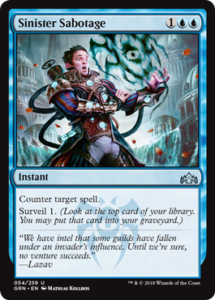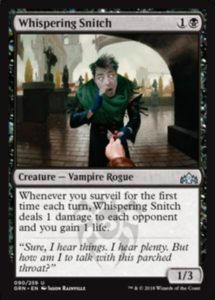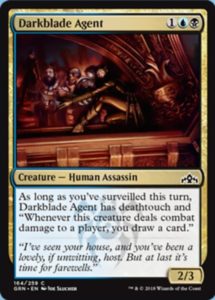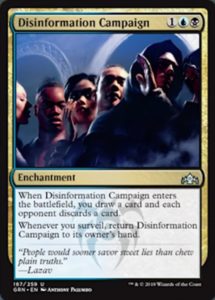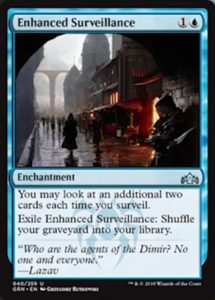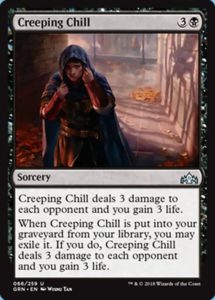When Surveil was spoiled, I thought, “Neat. A slightly more powerful Scry that feels crueler and more Dimir-y. It has good synergy with the other blue and black mechanics in GTR, Jump-start and Undergrowth.”
I didn’t expect Wizards of the Coast to do so much with it.
Surveil is decidedly more than Scry. Because it only gets one set to shine, Wizards can pull out all the stops and play. Accordingly Surveil has something in spades that Scry only hints at: flavor.
Surveil is used in such interesting, such clever, such ruthless, and such utterly Dimir ways. Today, let’s dive deep into Surveil and why it’s amazing.
Level 1 Design: A Simple Rider
This is how I expected Surveil to be used—the same way Scry is. Simple, clean, powerful, and predictable. Surveil is more skill-testing because binning cards is both more powerful than bottom them, but also feels worse (particularly for less experienced players). This feeling was compounded by all of the Surveil cards spoiled first: Unexplained Disappearance is precisely Voyage’s End with Surveil. Deadly Visit is a solid card, but mostly devoid of meaning and flavor. Sure, Narcomoeba is a cute combination with it, but it’s a future-shifted card they found a neat environment to include in, nothing more.
And then I witnessed more of what Dimir had in its arsenal. Like many right before Dimir strikes, I was stunned senseless.
Level 2 Design: A Simple Trigger
Surveillance lets you Extort people. Neat.
This is where I expected innovation to cease. We’ve seen Scry play in this vein with Flameblade Adept and Knowledge and Power—the only two Scry-matters card to the best of my recollection, unless you count cards like Riddle of Lightning.
Then I saw Darkblade Agent and it all clicked. With Dimir, you are the spymaster. Your creatures are spies gathering intel for you. Every time your spy network probes Ravnica, your agents find the perfect spots to strike. Like most intel, this information’s utility has a time limit.
Darkblade Agent isn’t alone in playing in this level 2 design space—Thoughtbound Phantasm is a similar design, but with less flavor (I guess the more ideas you gather, the more powerful or actualized this thought-eating spirit gets?). Dimir Spybug does this same thing, though the idea of more surveillance leading to more spybugs being requisitioned seems a stronger link.
Level 3 Design: A Subtle, Thematic Trigger
Ermagerd. You share one lie with the world, confusing your enemies and benefiting from knowing the truth. However, a single lie can only accomplish so much. So you research what else folks are susceptible to believing, and so birth a new lie. The flavor here is absolutely smashing.
Disinformation Campaign does highlight a disconnect between Surveil’s flavor and gameplay—spycraft is learning your enemies better than they know themselves, but Surveilling involves exclusively studying your stuff, not your opponents’. Now, I’m not advocating for Surveil to instead be a Fateseal variant, because Fateseal is a net negative fun mechanic, as most folks who’ve faced down a Jace, the Mind Sculptor can likely attest. But it bears noting that the value of good gameplay almost always trumps that of perfect flavor.
Surveil is about developing an information network and leveraging it to outmaneuver your opponents, and it works with aplomb. And, while we’re on the subject of ludo-narrative dissonance,* what the entire library and summoned creatures are** is a bit hazy and unintuitive, but a bit of thematic weakness isn’t a bad thing if the gameplay and flavor fit well.
* Ludonarrative dissonance is game designer speak for ‘when gameplay does not resemble or is in tension with what it is abstracting.’ Magic, for example, is an abstraction of a magical duel between Planeswalkers. Ludonarrative consonance, ‘when gameplay does a good job of feeling like what it’s thematically about,’ is the opposite of ludonarrative dissonance.
**The library is an abstract representation of a Planeswalker’s memories, or ideas waiting to surface. The graveyard is also an abstract representation of memories, but also sometimes a literal graveyard for creatures (but not always, since Ajani, Adversary of Tyrants is narratively recruiting a new ally, not reanimating an old creature. Summoned creatures are magical constructs of thought and memory, since Planeswalkers can no longer summon creatures across planes. This is some of the weirdness inherent to Magic most people probably don’t think much about, but is cool to think about.
Level 4 Design: A Subtle Rider
YASSSSSSS. Enhanced Surveillance hearkens back to my favorite Fluxx card, X = X + 1 (aka Inflation, if you own a newer copy of Fluxx). Thematically, you’re spending resources to develop your spy network, making your spies twice as good at gathering intel. Later on, with your network (and library) depleted; you dismantle it, scatter your agents to new cells, and begin again.
It’s incredible to me how many stops were pulled out for Surveil. There have only ever been two Magic cards that care about scrying; but Surveil not only gets more than that, it gets flavor in spades. Because Surveil puts cards in the graveyard, rather than the bottom of your library, you have access to every idea you ever Surveil—even one you didn’t need at the time (like Jump-start spells or a Blood Operative). It enables shenanigans like Creeping Chill and Concoct of Connive/Concoct. It even lets Lazav, the Multifarious transform into a Phyrexian Dreadnaught.
The big picture
Surveil provides an excellent example of conservation of design space. Some things, like Scry and Planeswalkers, have been and will be around for a long time, but there’s only so much design space to be mined. Planeswalkers have almost exclusively been restricted to activated abilities, have few X-cost loyalty abilities, and almost always follow the pattern of having two usable abilities the turn they enter the battlefield and one they can’t (usually the Plus, Minus, Ultimate combo).
Surveil is the opposite of Scry. It will so obviously not be coming back anytime soon (because Scry exists, because Surveil is semi-specific in flavor, and because Ravnica guilds usually don’t reuse mechanics when they return. Wizards of the Coast gets to pull out the stops and showcase a whole bunch of different methods Surveil can be used. Scry is a workhouse mechanic designed for card-smoothing, whereas Surveil is a subtle, multipurpose mechanic that does what Scry does but also enables all sorts of shenanigans (only some of which have been spoiled at the time of writing). Sometimes, a subtle difference is all it takes to make a drastically different mechanic, and subtlety is House Dimir’s greatest weapon.
And, as always, thanks for reading.
—Zachary Barash
Zachary Barash is a New York City-based game designer. He designs for Kingdom Death: Monster, has a Game Design MFA from the NYU Game Center, and does freelance game design. When the stars align, he streams Magic.
His favorite card of the month is Syndic of Tithes. Sometimes, a simple but powerful mechanic on a simple, but serviceable is all a card needs to shine.


